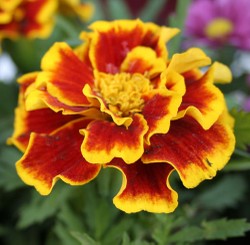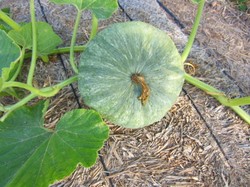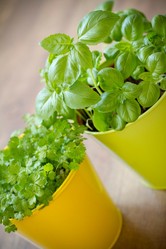If you are looking for a small garden space, or an extension to an existing garden, then the Earthbox might be the solution for you. Essentially, the Earthbox looks like a large window box, except it has a unique water reservoir. There are pros and cons to planting this way, so you will need to consider what you wish to grow in it. My Earthbox was an unexpected gift, and I've certainly put it to good use. I have been using my Earthbox for more than ten years for both flowers and vegetables. Here is what worked and didn't work for me.

Gardening with an Earthbox – My 10 Years of Experience
by dlstewart
I have been growing vegetables and flowers in an Earthbox for over 10 years. Learn what grows well.
Description
The Earthbox is a large rectangular 2.0 cubic foot planter. There is a water reservoir at the bottom. Above the reservoir is a horizontal platform that acts as the base for the soil and fertilizer. A vertical plastic pipe along one side is where the water is added. The kit comes with two black plastic covers that are edged with elastic to cover the top of the Earthbox, reducing moisture evaporation and preventing weed growth.
Setup
I highly recommend reading the instructions. They include layout diagrams for the plants. The fertilizer also needs to be added a certain way, depending upon how the plants are set. Assembly is easy and takes about 20 minutes. (The kit does not come with soil. Also, 2 cups of chemical fertilizer per plant is recommended or 3 cups of organic fertilizer.)
Before adding soil to the box, make sure the box is where you wish it to stay. Once the Earthbox is filled with soil, fertilizer, and plants … it is very heavy. Even though the manufacturer says this box can be moved around the yard, the box is difficult to relocate unless the Earthbox you bought came with wheels.
A great feature is the water overflow hole at the back of the Earthbox. Just make sure the hole is positioned so any excess water empties where you wish it. My box is placed near other plants, which benefit from the water overflow.
Manufacturer Planting Suggestions
The Earthbox can be used to grow flowers, herbs, fruit and vegetables. Here is a list of recommended plants, and in parenthesis are how many will fit in the Earthbox:
artichokes (2), beans (16), broccoli (8), Brussels sprouts (8), cabbage (8), cauliflower (8), celery (8), chard (8), corn (16), cucumbers (4), eggplants (2), flowers (8), greens (6), herbs (8), peppers (8), kohlrabi (8), leeks (8), lettuce (8), melons (4), okra (16), onions (8), peas (16), salad greens (8), spinach (8), squash (6), strawberries (8), tomatoes (2)
My Experiences
Over the years, I have tried a variety of plants in the Earthbox. It is interesting to experiment and see what grows best.
Tomatoes – I start my tomato seed indoors and then transplant the plants outside when the soil is warm enough (around Memorial Day). Several times I tried growing tomato plants in the Earthbox. Compared to the tomatoes I grow in my regular vegetable garden, the Earthbox tomatoes were failures. The plants in the garden grow about five feet tall and are lush, contained in tomato cages. The Earthbox tomatoes grew about three feet and produced much smaller tomatoes. I no longer use the Earthbox to grow tomatoes.
Bell Peppers – I also start my peppers indoors from seed and later transplant them outdoors. I have great success growing Ace F1 peppers. When I grow these peppers in the garden, harvest is plentiful. The plants in the Earthbox produced less peppers, and the peppers were smaller in size.
Hot Peppers – My experiment with hot peppers was more successful. The hot pepper plants in the Earthbox produced a good crop of peppers. The plants produced as well as the plants in the main vegetable garden.
Zucchini – I start my squash plants indoors from seed, too. The zucchini plants in my vegetable garden far surpassed the same type of zucchini plants growing in the Earthbox. The Earthbox zucchini produced nice leaves and lovely flowers … but no zucchini formed.
Eggplant – My sister-in-law also has an Earthbox and bought eggplant plants from a local nursery. The plants thrived in the Earthbox and produced a lot of eggplant.
Carrots – One year I experimented with carrot seed, sowing the seed directly into the Earthbox. I did not place the black plastic cover over the box. The variety I planted grew about 6-inches long. Those carrots were some of the best I have ever grown, and they tasted delicious.
Marigolds – A couple of years I grew marigold plants in the Earthbox, each year a different variety. I started the plants from seed indoors and transplanted them into the box when it was warm enough outside for the plants. The flowers were gorgeous.
Nasturtiums – Last year I planted nasturtium seed directly into the Earthbox. I can’t believe how enormous those plants and flowers grew. Beautiful! I had planted the same type of nasturtiums in some hanging baskets, and the flowers were nowhere near as spectacular as those growing in the Earthbox.
Care & Storage
I am beginning to think this Earthbox is virtually indestructible. The first five or six years, I stored the Earthbox in the garage during the winter. Then one year I never got around to storing it. The Earthbox survived a New England winter without issue. So I’ve left it out every winter since. The plastic is strong and the box looks great.
Summary
I am delighted the Earthbox is part of my gardening experience. Not every crop planted has been a success, but I’ve had fun. This year I am planting a mix of marigolds and nasturtium in the Earthbox. I’m looking forward to a cascade of vibrant color at the edge of my larger garden.
Enjoy the day!
Dawn
http://dlstewart.com
Copyright 2015 Dawn L. Stewart
You might also like
Growing Plants in Straw BalesThose who want to garden in small and constrained spaces with hard surfaces c...
Experiments with Mini Vertical Container GardeningI have moved into a space that doesn't allow for a garden. I was determined t...









 Happy Gardening with the Greenland Raised Garden Kiton 05/07/2015
Happy Gardening with the Greenland Raised Garden Kiton 05/07/2015
 Removing Ice with a Suncast Heavy-Duty Ice Chopperon 03/02/2015
Removing Ice with a Suncast Heavy-Duty Ice Chopperon 03/02/2015
 One of His Favorite Rattle and Roll Toys -- Hartz Midnight Crazieson 01/24/2015
One of His Favorite Rattle and Roll Toys -- Hartz Midnight Crazieson 01/24/2015
 How to Successfully Grow Cat Grass for Kittyon 01/21/2015
How to Successfully Grow Cat Grass for Kittyon 01/21/2015



Comments
Hi! No, I did not use the cover. Have a great day.
When you planted the nasturtiums directly, did you use the cover? Many thanks!
Growing tomatoes from seed in some latitudes requires glasshouse conditions. Where I am in North West England I cannot grow tomatoes from seed in the open air. Do what I do and purchase tomato seedlings from a plant nursery/garden centre. Keep them frost free, as frost is a tomato killer. Good luck.
lol ... I've been gardening for over 30 years. I'm inclined to think that perhaps the Earthbox wasn't in an ideal location. The tomatoes in my regular vegetable garden grow beautifully. I started seed indoors again this year, and the plants are strong, so they should do great when I plant them outside in a few weeks once the soil is warm enough. Wishing you a great day.
My tomato plants always did wonderful in the earthbox. I'm not sure what you did wrong to have a complete failure, but maybe you just need some more experience at growing plants.
Hi Karen .. I'm jealous. Maybe I should experiment with tomatoes again and move the box go a different location. Sounds like your tomatoes did very well!
Not sure why you have trouble with tomatoes - I have grown tomatoes in my earthbox for the past 5 years and they grow over 7 foot tall and produce so much I have to share. My squash does beautiful as well.